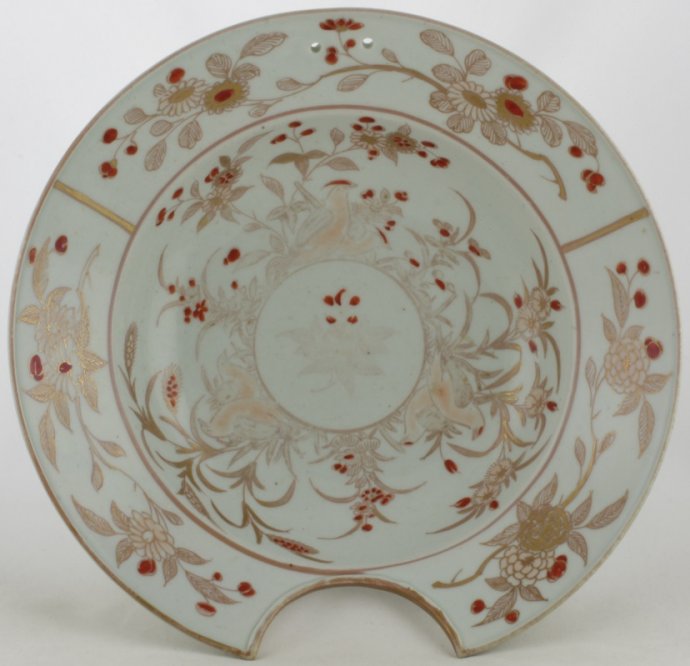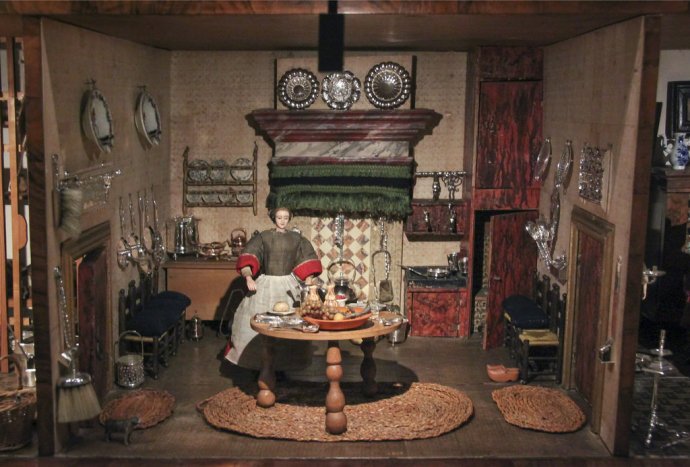Sold Ceramics

Sold Ceramics - Sold Japanese Imari 1690-1800 - 'Gold' Imari - Page 1
Object 2012036
Shaving bowl
Japan
1700-1730
Height 77 mm (3.03 inch), diameter of rim 280 mm (11.02 inch), diameter of footring 110 mm (4.33 inch), weight 1,054 grams (37.18 ounce (oz.))
Shaving bowl on footring with a spreading flat rim, in it a saved semi-circular section below and two small glazed holes opposite the cut-out section of the rim. On the base one single spur-mark. 'Gold' Imari, decorated in gold, iron-red and a light pinkish gold wash with a flowering peony spray in a central roundel surrounded by grasses and three groups of flowering plants each with a pair of birds, namely millet and quail, carnation and crested grouse and double camellia with partridge. On the rim sprays of peony, double magnolia and double camellia.
The quail was a popular motif and occurs on all kinds of Arita porcelain. As a fighting bird, it symbolises courage. Quail and millet indicate autumn. The quail was extensively copied on 18th-century porcelain. Some of the flowers and birds in this complex decoration are rather stylised, making identification somewhat difficult. Some sherds of similar wares have been excavated at Deshima. (Jörg & Van Campen 1997, p.213), (Jörg 2003/1, pp.115-116 & p.201)
This shaving bowl is a magnificent example of the 'gold' Imari group. No underglaze blue or other enamels are used, the light pinkish wash lending sufficient contrast to the brighter red and gold. In the collection of Oriental Ceramics of the Groninger Museum is an identically decorated teaset that consists of an identical teapot / hot water-pot, six cups and saucers for tea or coffee, six chocolate cups with covers and saucers, a bowl with an overturned rim that might have been a sugar bowl and an ewer which may have been used as a milk jug but could also have been a condiment jug in a dinner set with the same design of which parts are also in the Groninger Museum. The set entered the Groninger Museum in 1899 as a bequest of the local collector, Mr. Mello Backer. It is likely that this teaset was ordered together with the dinner set.
Besides dinner services, covered jars, tea, coffee and chocolate sets decorated in 'Gold' Imari with this design, also other utilitarian or luxury items were ordered after a Western model. These included cylindrical beer mugs, chamber-pots, cuspidors and shaving bowls therefore this shaving bowl can be considered a Japon de commande object. (Jörg 2003/1, p.164, cat. 188)
For other objects decorated with this design in 'gold' Imari, please see:
- Japanese porcelain. A collector's guide to general aspects and decorative motifs, (P.L.W. Arts, De Tijdstroom, Lochem, 1983), p.135, Plate 80.
- Imari-Porzellan am Hofe der Kaiserin Maria Theresia, exhibition catalogue (Hetjens-Museum, Düsseldorf, 2000), p.49, cat. 10.
- Fine & Curious. Japanese Export Porcelain in Dutch Collections, (C.J.A. Jörg, Hotei Publishing, Amsterdam, 2003), pp.115-116, cat. 123 & 200-201, cat. 256.
-
Sold Ceramics - Sold Japanese Imari 1690-1800 - 'Gold' Imari - Page 1 - Object 2010574.
-
Japanese Imari 1690-1800 - 'Gold' Imari - Page 1 - Object 2012034.
-
Sold Ceramics - Sold Japanese Imari 1690-1800 - 'Gold' Imari - Page 1 - Objects 2011745 & 2011746.
The first documentary evidence for scheerbeckens or shaving bowls is a 1662 invoice from the Director of the Deshima factory in Nagasaki regarding an order for 258 of these dishes for shipment to the Netherlands. After this point shaving dishes become a regular export item.
Shaving bowls were used by barbers and were indispensable in the Dutch household too. They were made of earthenware, pewter, copper and even silver. Beside their function as a shaving utensil, they had an alternative use, namely to let blood from a vein in the arm during blood-letting. This was a medical procedure thought to drain bad blood from the system, which was also performed by the barber/surgeon. In the seventeenth century, regulations were put in place in England to govern what barbers were permitted to do. Thus they became confined to bloodletting and treating external diseases. In Prussia the barbers' and the surgeons' guild joined in 1779, and it was said of great Prussian surgeons that they had risen "up from the barber's bowl”. Both purposes explain the semi-circular saving. The two holes in the rim are for a cord or string. A shaving basin with the actual silk string still attached was excavated in Amsterdam. The string was used to suspend it from the client's neck to catch lather and water during shaving, or to hang the bowl on the wall thus implying that owners also appreciated the bowl for its decorative value as well as its function. Shaving bowls can be seen hanging on the wall as such in some dollhouses.
Cornelis Troost, Arlequin toovenaar en barbier, 1738, Mauritshuis, The Hague, Netherlands, inv. nr. 184. In spite of the satirical intent, the painting reflects actual usage.

The doll’s house of Petronella Dunois (1650-1695), c. 1676, Rijksmuseum, Amsterdam, the Netherlands, inv.nr. BK-14656. Two shaving dishes are suspended on the left wall.
Chinese shaving bowls usually have the holes in the footring instead of the rim. Most Japanese barber’s bowls are more or less rounded, whereas Chinese barber’s bowls usually are oval (for a Chinese example, please see the 'Sold Archives' object 2011301)
Larger pieces of Japanese porcelain such as plates, bowls and dishes, had a tendency to ‘sag’ during firing. That’s why they were often supported in the kiln by small stoneware pillars. After firing, these small cones or spurs which adhered to the base were knocked off, leaving behind small unglazed rough patches or spur marks on the base. The supports were arranged in X, Y or other patterns. Whether they have any relevance to dating or an attribution to a specific kiln is still unresolved. These spur marks are typically Japanese and are rarely seen on Chinese porcelain.
Condition: Some wear to the decoration due to use.
References:
Arita 2000, p. 91, cat. 282, p. 152, p. 163 & p.233
Jörg 2003/1, p.14, pp.115-116, p.164, pp.184-185 & pp.200-201, cat 123, & cat. 256
Price: Sold.



 create websites
create websites